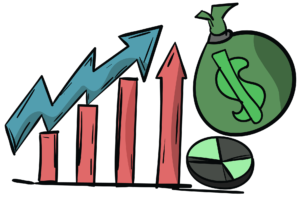Personal finance dashboards have revolutionized how individuals manage their monetary affairs. They emerged recently. These tools allow them to oversee, analyze, and optimize their finances. A Personal Finance Dashboard is an indispensable tool. It offers a comprehensive snapshot of one’s financial landscape in a single interface. This guide delves into the potency of these dashboards. It unravels their functionalities and illuminates strategies to leverage their full potential. This can help maximize investments and achieve financial prowess.

Understanding the Essence of Personal Finance Dashboards
Managing personal finances has undergone a paradigm shift in this digital age. This is thanks to the advent of Personal Finance Dashboards. These powerful tools serve as a singular hub. They total multifaceted financial data into a centralized interface. Let’s delve into the essence of these dashboards. We’ll explore how they empower individuals to understand their finances better.
Empowering Financial Visibility and Control
At its core, a Personal Finance Dashboard is a mix of financial data from different sources. These sources include bank accounts, investment portfolios, credit cards, and loans. A unified platform consolidates the data. This consolidation facilitates a holistic view of an individual’s financial standing. It presents real-time insights into income, expenses, investments, and debts.
Harnessing Real-Time Data for Informed Decision-Making
One compelling feature of these dashboards is their ability to provide real-time updates and analyses. Individuals gain valuable insights. They offer a comprehensive overview of spending patterns, investment growth, and saving trends. This helps them make informed financial decisions.
Maximizing Investments through Personal Finance Dashboards
Personal Finance Dashboards serve as invaluable tools for scrutinizing and refining investment portfolios. These dashboards provide detailed insights into asset allocation, performance metrics, and diversification. Astute investors use them to identify underperforming assets. They then make strategic adjustments to optimize returns.

Optimizing Investment Strategies
Utilizing a Personal Finance Dashboard allows investors to scrutinize their investment portfolios. It enables tracking of asset allocation, performance metrics, and diversification. This empowers individuals to identify underperforming assets. They can then make strategic adjustments to optimize returns.
Setting Financial Goals and Monitoring Progress
These dashboards ease the establishment of clear financial objectives. They also provide tools for tracking progress toward these goals. The dashboard’s visualization tools aid in monitoring milestones and staying on course. Whether saving for retirement, an emergency fund, or a specific investment target.
Choosing the Right Personal Finance Dashboard
Selecting a suitable Personal Finance Dashboard hinges on several crucial factors. Pivotal considerations include a robust interface and strong data security. They must be compatible with financial institutions and offer customization options. It’s important to choose a platform that aligns with individual preferences. This will ensure a seamless financial management experience. Strong security is also important.
Factors to Consider
The success of the Al Finance Dashboard hinges on various factors. These include the user interface, data security, and compatibility with financial institutions. Customization options are also included. Opt for a platform that aligns with individual preferences. Choose one that offers robust security measures. This ensures a seamless and secure financial management experience.
Top-rated Personal Finance Dashboards
Several renowned personal finance dashboards have gained prominence in the market. Each has its unique set of features, catering to diverse user requirements. Platforms like Mint, YNAB (You Need a Budget), and Personal Capital stand out for their interfaces. They have insightful analytics and effective goal-setting tools.
Strategies for Leveraging Personal Finance Dashboards
Frequent and diligent financial data monitoring through a Personal Finance Dashboard is crucial. It’s essential for effective financial management. Regular reviews help identify trends and areas for improvement. They also help seize opportunities for enhancing investment performance. Consistency in observation ensures a proactive approach towards financial well-being.

Regular Monitoring and Review
Consistency in monitoring financial data through the dashboard is pivotal. Regular reviews help identify trends. They also help recognize areas for improvement. Plus, they help seize opportunities to enhance investment performance.
Utilizing Budgeting and Tracking Tools
Employing the budgeting and expense-tracking features of these dashboards fosters disciplined financial habits. Individuals can curtail unnecessary expenditures and divide resources more. They can do this by setting budgets, categorizing expenses, and analyzing spending patterns.
FAQs on Personal Financial Dashboards and Financial Management

1. How do I create a personal financial dashboard?
Creating a personal financial dashboard involves several steps:
- Gather Financial Data: Collect information from various sources such as bank accounts, credit cards, investments, loans, and expenses.
- Choose a Platform or Software: Select a tool or software that suits your preferences. Options range from dedicated apps like Mint or YNAB to spreadsheet software like Excel or Google Sheets.
- Organize Data: Categorize and organize your financial data into income, expenses, savings, investments, debts, and net worth.
- Design the Dashboard: Create visual representations such as charts, graphs, and tables to display the information. Arrange these elements in a clear and understandable layout.
- Regular Updates: Ensure you update your dashboard to maintain accuracy and relevancy.
2. What should a financial dashboard include?
A comprehensive financial dashboard should encompass the following:
- Income and Expenses: Clear breakdown of income sources and categorized expenses (e.g., housing, utilities, groceries, entertainment).
- Budget Tracking: Comparison of actual spending against set budgets or targets.
- Savings and Investments: Overview of savings accounts, investment portfolios, asset allocation, and performance metrics.
- Debts and Liabilities: Display outstanding debts, loans, credit card balances, and repayment progress.
- Net Worth: Calculation of assets minus liabilities to determine financial health.
- Visual Representations: Using charts, graphs, and tables to visualize better and understand financial data.
3. How do I manage personal finance in Excel?
Managing personal finance in Excel involves:
- Creating a Budget Spreadsheet: Design a spreadsheet to track income and expenses, categorize spending, and calculate totals.
- Utilizing Formulas: Use Excel formulas to automate calculations, such as summing up expenses, calculating savings rates, or analyzing investment growth.
- Setting Up Graphs and Charts: Create visual representations of financial data to comprehend trends and patterns.
- Regular Updates: Update and maintain the Excel sheet to ensure the accuracy and relevance of financial information.
4. What is the dashboard of a financial model?
The dashboard of a financial model is a condensed display of key financial metrics and performance indicators. It offers a summarized view of various aspects of the financial model, such as:
- Financial Performance: Revenue, expenses, profits, margins, and cash flow.
- Key Performance Indicators (KPIs): Metrics relevant to the specific industry or business, like customer acquisition cost (CAC), churn rate, or sales growth.
- Visual Representation: Graphs, charts, and tables presenting trends, comparisons, and variances in the data.
- Forecasting and Scenario Analysis: Predictive elements showcasing potential outcomes based on different scenarios or input changes.
Conclusion
In conclusion, Personal Finance Dashboards have given individuals a potent tool. They can use it to master their financial destinies. Using these dashboards provides a panoramic view of one’s financial landscape. It empowers users to make informed decisions. They can optimize investments and move toward financial prosperity. By using these dashboards, individuals can steer their investments toward growth. They can also streamline financial goals and achieve fiscal well-being.
The financial landscape continues to evolve. Embracing the capabilities of a Personal Finance Dashboard is not an option. It is a strategic imperative in securing one’s financial future.





